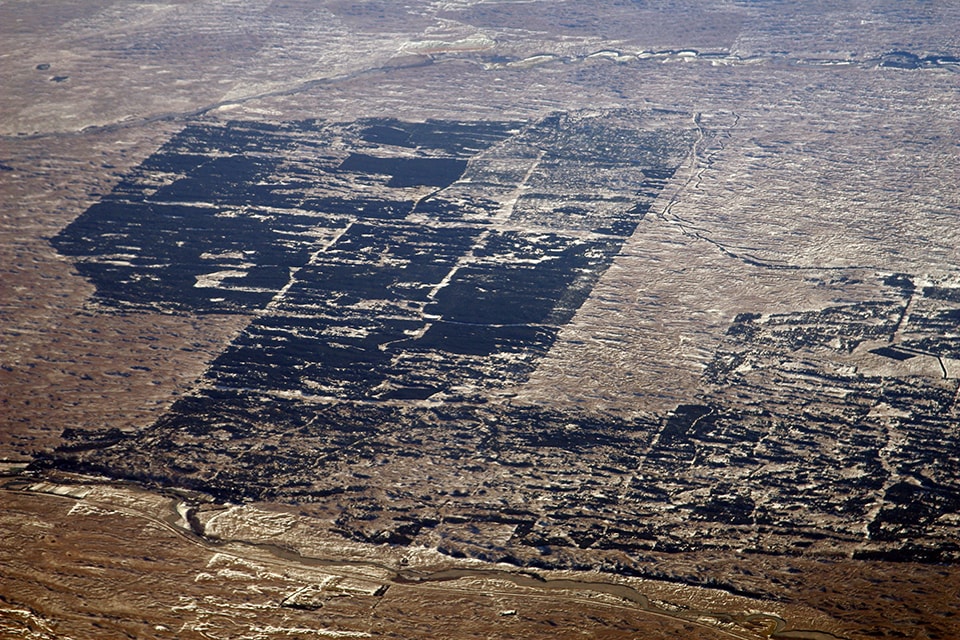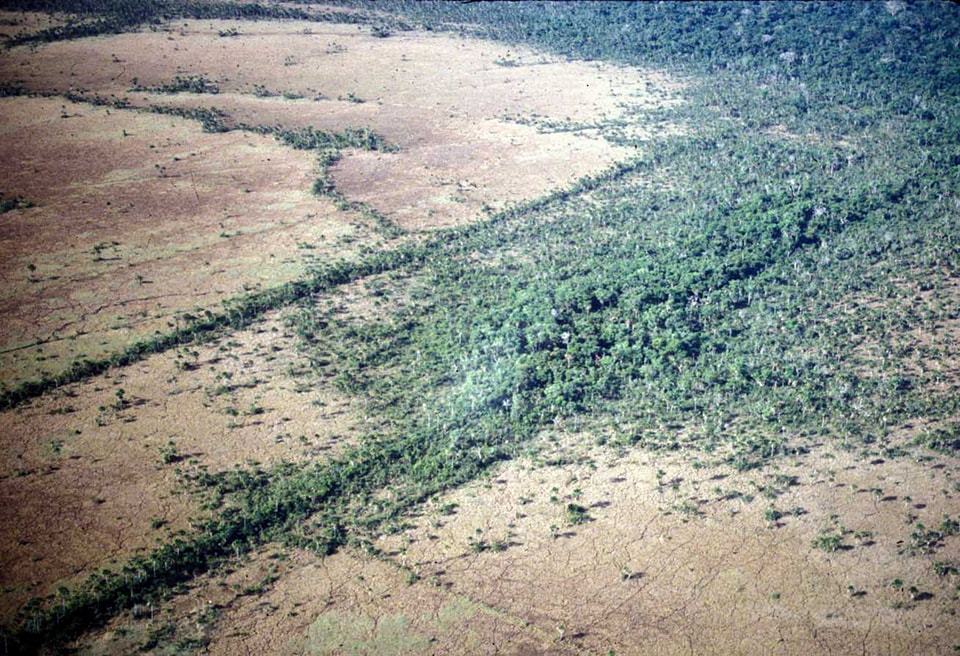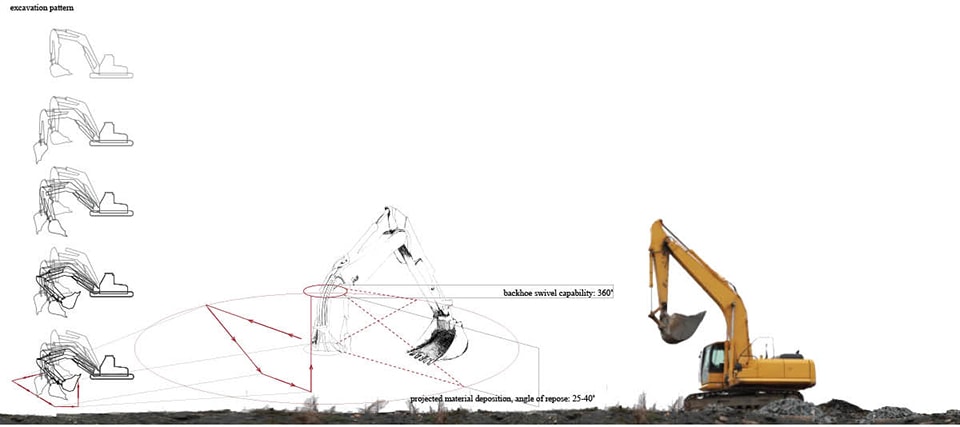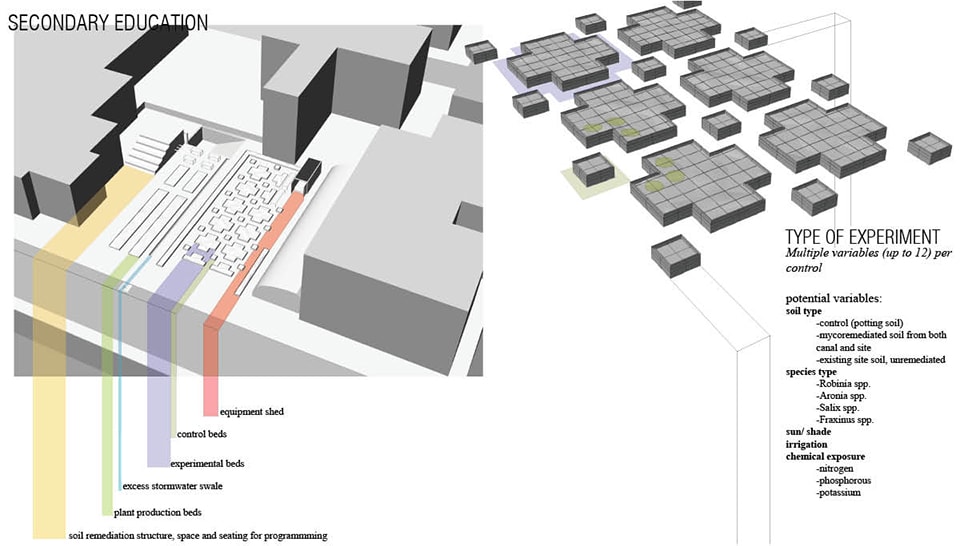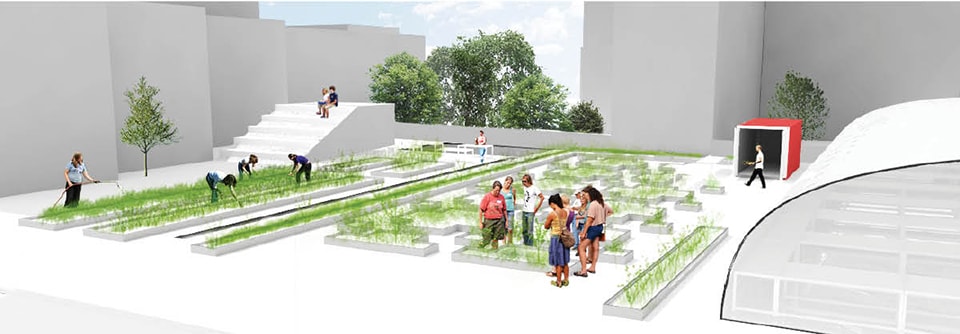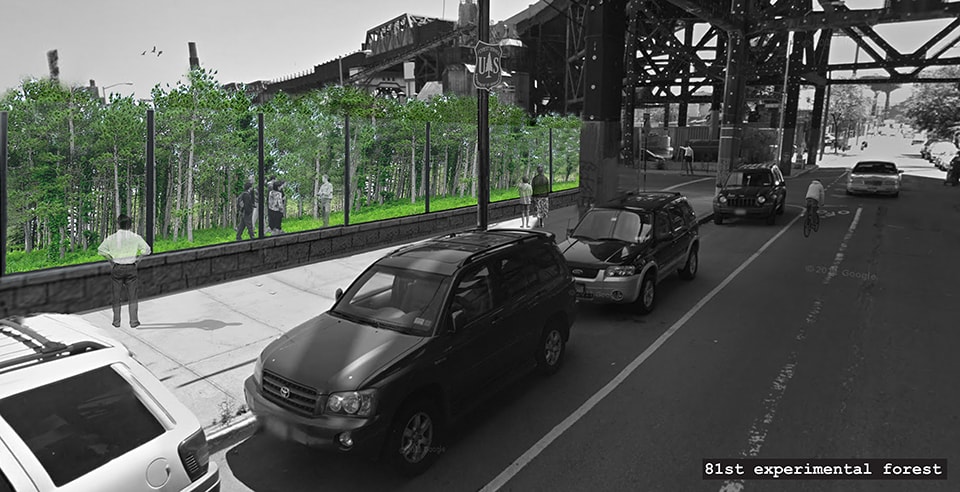“The foresters and their allies begat conservation and multiple-use. The architects and their allies begat regional planning. Together, the two offspring begat geotechnics.”
– Benton Mackaye, From Geography to Geotechnics [1]
“the history of this discovery [of the forest as a unique ecological type] is a separate and as yet unwritten chapter in landscape studies. It starts with a legal definition, more than a millennium ago, of the forest as a political space, a space with its own special law.”
– JB Jackson, “A Pair of Ideal Landscapes” [2]
The relationship between landscape architecture and fields such as planning and horticulture has historically been important and productive in the making of urban landscapes. Selecting and arranging specimens and species into formal compositions for aesthetic or ecological effect, or positing a landscape project as a generative and organizational structure for urban networks are practices that can be seen in the work of historical and contemporary figures ranging from Beatrix Farrand and Roberto Burle Marx to Piet Oudulf and Michael Van Valkenburgh Associates. Yet there exists an equally deep, though often ignored, relationship between landscape architecture and forestry [3]. What might be recovered or created if contemporary landscape architecture were to turn toward forestry, both learning from the practices used to sustain and study forests, and contributing to the shape these might take in the city? By understanding forests as an urban landscape type, we may find new sites of resistance to the city’s consumption-driven processes, and a more resilient and adaptive ecology that encourages active participation by people.
The multiple-use mandate of the US Forest Service offers a robust conceptual and technical framework for understanding and engaging the critical social and ecological issues facing cities today. The multiple-use mandate was originally developed to manage large woodland tracts located far from population centers. In the context of a city, addressing local issues necessarily entails grappling with a wider range of cultural values and social forces than forests in rural areas typically accommodate. By drawing on landscape architecture’s history of integrating and hybridizing social and environmental processes in cities it might be possible to recover and refine the conceptual tools needed to make this translation.
We propose that landscape architecture should work to adapt the multiple-use mandate of the US Forest Service to contemporary city conditions. If urban forests are understood as a multiple-use landscape type operating locally at a variety scales, they may present an alternative for negotiating some of the issues facing today’s cities. To that end, we examine the mechanisms of the multiple-use mandate and some of its historical antecedents; suggest four concepts that might be useful in adapting it to the urban context.
The Nebraska National Forest: this aberrant landscape of evergreens in the sandhills of Nebraska was established in 1902 as an experiment to see if forests could be created in the treeless areas of the Great Plains for use as a national timber reserve. This effort, anticipated by the work of landscape architect Horace Cleveland, resulted in a 20,000 acre forest, the largest human-planted forest landscape in the United States.
Beyond Parks
Most public landscapes projected in cities today tend to be understood as one of four popular landscape types: plaza, park, garden, or promenade. Of these landscape types, park is by far the most promiscuous. The search for an appropriate response to contemporary public landscape issues often results in an effort to make parks do more. This typological tendency is problematic because the park is a landscape type that conjures a set of fairly specific compositional techniques, images, and experiences—all of which have their own potentials, limitations, and their own history.
Traditionally the power of parks has been their ability to fulfill two functions, simultaneously driving urban development while offering a respite from some of its effects such as traffic, noise, pollution, or the lack of access to green spaces. Municipal park-making as an urban practice rose to prominence as cities were undergoing explosive growth through an excess of industrial production [4]. Designers such as Frederick Law Olmsted and Horace Cleveland imagined parks as a way to contrast and combat the ills generated in industrial capitals in the 19th century [5]. The urban park resulted from a finely tuned set of techniques and methods of construction and composition such as creating strolling promenades or points of prospect. These were intended to contrast the filthy, disease-ridden, ever-expanding industrial city with a sanitized view of the woodlands and fields that it replaced. Through this reconstruction parks became a public form of the aristocratic pleasure ground [6].
American park-making was seen as a way to organize the development of the city in ways that were beneficial to political elites and those rich enough to take part in the real estate market. Whether such class sentiments were reflected in the intentions of the designers is highly debatable, but as Rosenzweig and Blackmar argue in their book The Park and the People, park-making has been intertwined with real estate development from the beginning [7].
In some instances these competing urban agendas have been resolved with a certain grace. Olmsted’s emphasis on the unique geological or topographical features of a site meant places identified as ideal parklands were often the most difficult places to build housing. Sites that were difficult to build on were turned into parks that fulfilled important social and environmental functions while adding value to the surrounding real estate [8]. The power of Olmstead’s ideas and the clarity with which he presented them have given Olmsted a legacy as the father of American landscape architecture and the great champion of park-making. And yet, a closer reading of Olmsted reveals a much more rigorous and subtle landscape typology at work.
The plan for the Buffalo Public Landscape System called for five large public spaces, only one of which was a traditional park: the Park, the Parade, the Asylum [9], the Cemetery, and the Front. His biggest and best known work in Boston was known as The Fens, and his work at the Biltmore Estate in western North Carolina laid the groundwork for the creation of modern forest landscapes. There Olmsted convinced the wealthy industrialist George Vanderbilt to forgo the creation of a large park-like landscape and instead hire the young forester Gifford Pinchot to implement reforestation protocols across a huge region that had been subjected to massive deforestation. Much of the former estate now forms the Pisgah National Forest.
For Olmsted the distinction went beyond names–his landscape interventions were not simply themed parks but in fact were fundamentally different landscape types that responded to different contexts and performed specific social and environmental functions [10]. The subsequent false equivalence of urban landscape-making with park design has resulted in an impoverishment of landscape architectural practice. Parks, with their emphasis on a fairly narrow range of recreational uses, privilege a specific set of cultural values that aren’t always appropriate in contemporary cities where ever-changing social dynamics and shifting economic climate place demands on public landscapes that fluctuate on different time scales.
Emphasis on the social and cultural aspects of landscape-making have enabled the creation of enduring and appropriate modern landscape types related to the park. But continued development in this vein has yielded proliferation of leisure-parks for wealthy cities, with riverfronts and former industrial sites everywhere being papered over and commoditized as social experience ready for consumption. Meanwhile, one sub-current in the practice of landscape design seeks to grapple with infrastructural landscapes [11], while another intends to expand the agency of the inhabitant [12], enabling everyone to make their own place, if only for a moment. A focus on material practices of production is one method that adds some steel to these well-intentioned impulses and enables the construction of new forms, programs, and landscape types. And the multiple-use mandate of forests is a tool for pursuing this.
Plan of Olmsted’s Buffalo System: labels of the major open spaces have been enlarged by the authors; note the names of the different landscapes, indicating a rich landscape typology for the city; plan created in 1914 by the Buffalo Parks Commission, from City of Buffalo Library.
Multiple-Use Landscapes: Beyond Consumption
In some cities today there are innovative and exciting projects organized around the idea of planting large numbers of trees. These are variously understood as efforts to improve quality of life, produce more wildlife habitat and increase ecological resilience, and construct green infrastructure, and are undertaken by local partners and municipal parks agencies. However, there are some important distinctions to make between these efforts and the approach of the US Forest Service [13]. The provenance of these efforts originates squarely within the tradition of park-making. This fact tends to orient them toward the paradigm of recreation and conservation and emphasizes the composition of pleasing scenery that contrasts with the aesthetic of working landscapes. Forests, construed from the beginning as a working landscape, rather than its antidote, offer an alternative.
In his anecdote on the foundation of modern forestry in the United States, Benton MacKaye noted that at the beginning of the twentieth century “each national forest contained much more than trees… Wood, soil, power, ore, the ‘big four’ resources, all were involved in one wide complex” [14]. For MacKaye forests were understood through a conceptual framework of multiple use with the ultimate objective of watershed management at the regional scale. And while actual trees were a critical component of that, the forest itself was a much more complex and heterogeneous assemblage than an agglomeration of individual trees.
A US Forest Service forest is not merely a sum of all the trees in a given area, such as a city’s boundaries or a large rural tract. A USFS forest is a legal and cultural definition for a type of landscape that encompasses a variety of ecotones and constructions ranging from grasslands, marshes, wetlands and rivers to extraction facilities, experimental sites, campsites and shelters, offices, housing, and infrastructure in addition to stands of pine or quaking aspen.
The alliance of things that forms a USFS forest landscape is managed according to the multiple-use mandate. This framework is significant because it sets into dynamic relation the competing operative logics of a given landscape. Contrast this to the single-use mandate of the National Parks Service “to avoid, or to minimize to the greatest degree practicable, adverse impacts on park resources and values [so as to] provide for the enjoyment of park resources and values…” [15] In a national park, everything including conservation is about providing recreation. It is important not to conflate national parks with municipal parks, but they are historically related, and they are similarly limited in how they might be managed to respond to changing environmental factors and accommodate an expanding or altered range of social interactions and patterns of use.
The exact interpretation of the multiple-use mandate has often shifted since it was originally formulated. In his keynote address at the 5th World Forestry Congress in 1960, then-chief of the US Forest Service Richard McCardle laid down a clear explanation of how the multiple use mandate was then understood [16]. The five major uses of forest land of the USFS were: 1) wood production, 2) watersheds, 3) grazing by domestic animals, 4) habitat for wild game and fish, and 5) outdoor recreation. Interestingly, the current chief of the USFS, Abigail Kimbell, interprets the multiple-use mandate according to only four points: managing forests for 1) clean water, 2) wildlife habitat, 3) healthy vegetation, and 4) recreation [17]. This history can be taken as evidence of its dynamic capacity to respond to changing demands. That the mandate has proven to be malleable and adaptable to contemporary needs while maintaining a focus on core areas of concern related to watersheds is of particular importance when considering contemporary cities combating issues of environmental toxicity, rising sea levels and changing climatic patterns, as well as the need for local habitat provision and alternative forms of recreation.
Though the multiple-use mandate is interpreted contextually, there is always some component of material production and performance- providing habitat for game, energy production, timber harvesting, mineral extraction. Interpreted through this framework, urban parks similarly provide for diverse range of performance and service functions—from mediating stormwater and microclimate to providing active spaces of recreation and cultural production. However, these have traditionally been sublimated into the primary objectives of providing recreational space and improving real estate values [18]. This ability of parks is more a function of the inherent capacity of any landscape to perform and negotiate multiple competing functions than the conceptual framework of parks themselves. Whereas parks are consumptive- consuming resources and offering experiences for consumption- forests are fundamentally productive and pluralistic. Because of this they offer a promising avenue forward for public landscapes.
A Landscape Approach: Learning from Indigenous Geotechnics
The origins of modern forestry practices in the United States point to Olmsted and Pinchot’s work at the Biltmore Estate. The earliest roots of this type of large-scale forestry are typically attributed to advances made in Germany and France in the 19th century when forests began to be managed with a focus on sustained, maximal yields [19]. While the technocratic foundation of US Forest Service management practices are largely derived from that lineage, there are earlier examples indigenous to the Americas that demand inclusion in the discussion as landscape architecture returns to forestry. These historical examples offer important conceptual tools for more fully developing a landscape approach to urban forestry that can resist the technocratic values of maximization and efficiency as well as the consumptive tendencies of the contemporary city.
In his book Changes in the Land, William Cronon showed that indigenous peoples of New England intentionally altered huge swaths of mosaic forests, managing them through burning, planting, and clearing to generate ideal conditions over time for a wide range of wildlife species essential to indigenous ways of life [20]. For these societies the landscape itself was an artifact resulting from a plurality of site-specific cultural practices. Similarly, historian John Stilgoe noted that orchards and woodlots were common landscape types both in the town and on farm in 18th century New England. For that society these were productive landscapes that were sometimes public and had their own temporal and material demands:
Men faced a difficult decision. If they planted locust trees in their windbreaks they could be almost certain to have fifty-foot-high screens within twenty-five years; the silver poplar, the chestnut, the elm, the European larch, the silver maple and the Norway fir all grow extremely rapidly too, sometimes as much as thirty feet in ten years if the soil is rich… In the face of acute shortages of firewood and building timber, the nation’s farmers slowly relearned the lessons forgotten in the decades of clearing [21].
In the schematics described by both Stilgoe and Cronon, there is a certain slowness at work, as knowledge and the fruits of labor are passed down and added to across human generations. Labor and knowledge transfer of this kind demands that humans engage the capacity of landscape to negotiate competing demands at multiple temporal scales in an ongoing process of landscape accumulation.
Through his study of the Bauré society Clark Erickson concludes that in the past, indigenous people of the Bolivian Amazon “invested more energy in domesticating entire landscapes than in domesticating individual plant and animal species.” [22] By managing flood dynamics of the river through the construction and maintenance of infrastructures. This simple assertion that the domestication of the landscape itself can be the primary object of human intention and work, and not a mere epiphenomenon or derivative, is revelatory when considering contemporary cities and closely parallels Benton MacKaye’s concept of geotechnics. Importantly, in each of these cases methods of control were incomplete or open-ended. Rather than attempting complete control of biological, geological, and hydrological systems in the landscape, adaptive methods were developed that emphasized ongoing work and collaboration with specific dynamics of the landscape itself.
These landscape practices and concepts anticipated contemporary concerns in landscape architecture and planning and suggest that contemporary designers and communities have much to learn from models and methods of older indigenous examples in North and South America. Rather than solely materializing human intent and technical knowledge, they engaged the capacity of the landscape itself for surprise, leaving a space for novelty and engaging it through adaptive management.
Parallel causeways and associated canals covered with trees cut across the Bolivian savannah and connect raised forested islands in the Baures region of the Bolivian Amazon. Image by Clark Erickson [22]
Designing and Managing the Urban Forest Landscape
Currently most cities define the urban forest as the sum total of trees on public and private lands [23] (an agglomeration of trees) and discuss its function in broad categories like the environmental, social and economic. For example in New York, the Million Trees Project states this objective: “to bring the many environmental, health, social and economic benefits that trees provide to all facets of city life [by] creating 2,000 acres of forest on City parkland and other public open spaces by establishing new, ecologically healthy, multi-story forests.” Typical municipal goals for urban forests include increasing canopy coverage to certain percentages within specified timeframes.
It is telling that most describe the urban forest only in terms of its trees [24], and suggests that cities are missing an opportunity to conceptualize and manage the urban forest as a landscape, building upon the USFS model but adapting it for conditions that are particularly urban. We propose an urban forest landscape type based on four major concepts:
1. The urban forest landscape is productive and pluralistic, and must consider multiple, competing and evolving uses and users
Applying the USFS model of forest management and the techniques of long-term rural landscape management across the wildly diverse mosaic of urban land yields exciting potential for the emergence of hybrid and novel working landscapes. Mandated multiple uses can be prioritized to address the most acute problems of the place, and this reordering alters both the design of the forest and how it is managed. If reducing stormwater flows and increasing infiltration are a top priority, the forest might be managed to maximize canopy cover and vertical structure. By contrast, managing to expand habitat for specific wildlife species might call for a heterogeneous mix of patches with variable cover, species and stand age classes. When multiple objectives are combined and ranked (e.g. reducing stormwater flows while increasing red tailed hawk habitat), hybrid forest types emerge, each with its own potential compositions, images and experiences. In fact, the urban forest managed as a landscape might be dominated by treeless areas, such as recently cutover stands, meadow, canopy gaps and fenced sites undergoing soil management in preparation for planting.
Through their focus on material practices and productivity urban forests can much more actively contribute to how cities manage flows of materials like carbon, compostable waste, water and nutrients, and can be designed to foreground and accelerate specific desired performances. Although industrial in scale of operation, the material flows of forests differ from conventional industrial processes in that they involve abundant and renewable resources. Their characteristic ability to operate according to rates and quantities tied to the ability of the forest to process and digest means that they do not result in over accumulation. In this way, forests are productive systems that replenish rather than deplete urban ground [25]. And while timber production is a possibility, trees in cities have perhaps more potential to provide direct, smaller scale products and benefits to residents living nearby such as decreased home energy costs and a range of products including wood mulch, informal building materials, and food crops such as fungi and nuts.
2. The forest landscape operates locally at multiple scales
Urban forest landscapes have a unique relationship to the city. They are spatially distributed within the urban mosaic and always operate locally at multiple scales. Rather than obeying abstract logics such as building codes and profit margins, forests must respond to conditions adjacent and under foot. They must cope with specific site conditions such as the fertility, depth and percolation rate of the soil. They must tolerate contaminants, pest invasions and browsing by local populations of herbivores. Operating within an urban environment often means working in tight spaces with compacted and nutrient-poor or polluted soils. As a response, building an urban forest might not begin with trees at all, but with the restoration or generation of urban soils, a long-term process that significantly affects the viability and growth rates of plantings [26]. Trees disperse according to wind, animal use and planting preferences and patterns and intercept storm flows from adjacent paved surfaces to reduce runoff across watersheds. They provide pathways for movement for wildlife as part of a larger matrix connecting urban to rural.
Increasingly cities have become the venue for addressing complex issues like climate change, and some have taken the lead in studying and planning for how to achieve carbon balance at the local and regional scale. While technocratic infrastructures are centralized and standardized toward efficiency and single objectives, forests inside cities can help localize urban metabolic processes by sequestering carbon, purifying air, building soil, and recalibrating stormwater runoff, infiltration and evapotranspiration to nearer pre-development levels [27]. Increasing the amount of forest land cover measurably eases the burden on conventional stormwater infrastructure within an urban sewershed, and carbon-sequestering forests could help address a global issue in and around the city.
3. The artifactual forest is a product of cultural practices that accumulates value over time
Cultivating a forest in a city means creating favorable conditions for chosen outcomes over long periods of time, because of one fact: forests are slow. Developing the urban forest as a landscape may have to be learned and practiced in each city over generations of politicians, managers and residents, as each new case brings a unique set of evolving spatial conditions, regional contexts, environmental and social factors and disturbance regimes. This quality of ‘slowness’ also suggests that the urban forest (compared to other land uses) is relatively fixed in space. Over time it accumulates resources, memory, and knowledge through generations that imbue the landscape with value, enabling it to function as a place of resistance against the consumptive impulses of the city and to impel urban redevelopment elsewhere [28].
Unlike other managed forests, urban forests must also be responsive to the needs and preferences of large numbers of local residents. While potential forest benefits and services are prioritized at the municipal level, residents living nearby should be allowed to express their concerns and desires for both what the forest looks like and what it provides. Some urban residents may be unfamiliar with and even fearful of densely wooded tracts. Alternative forms of the forest landscape might be developed to respond to local values, encouraging emotional attachment to the forest as a respite within the city, a place for social interaction and a way to connect to a new home and country [29]. The urban forest landscape inspires attachment to place by extending the spectrum of outdoor sensory experiences and offering people an active role in its design.
4. Managing the forest as landscape leaves room for novelty and accepts disturbance
Disturbances and setbacks tend to be frequent in the urban context, and the impacts of drought, flood, windstorms, air pollution, and changing climate may be amplified because plants are living with increased stress due to difficult urban conditions. Recovery post-disturbance via the introduction of a new cohort group of trees may be slowed by the lack of nearby seed source areas. Both punctuated post-event and continuous monitoring and interventions by managers are needed, especially if performance targets are to be met. An approach that adapts to change while allowing room for unintentional novelty yields diversity and helps promotes resilience given high levels of uncertainty.
“Symbiotic Frameworks” speculated on the form and function of a future urban forest in the Gowanus area of Brooklyn, NY; pictured are the material operations that enable education and in-situ remediation of and creation of urban soils, allowing for large-scale reforestation in sync with primary education objectives; project by Cornell University students Emma Martone, Alex Reese, and Putu Dawkins as part of the Gowanus Forest undergraduate studio
The forest as an alternative model of urbanism
Urban forests point toward an alternative landscape type for the contemporary city. Urban forests are multiple-use landscapes operating locally at multiple scales that resist the consumptive tendencies of contemporary urban life and offer a way to adapt to changing conditions and social values. The urban forest is heterogeneous across scales due to diverse, constructed and anomalous site conditions, changing mandates and priorities, expanding and contracting funding streams and day-to-day concerns of community residents. It both resists and is resilient. Slow and local, it must abide by its own rates of change including those of growth and decay, but management of the forest must be highly adaptable, adept at foreseeing and navigating change as it comes from a variety of actors and agents.
The urban forest landscape can’t pretend to be ‘natural’; it’s a construction that emerges from factors on the ground and that relies on both ecological processes and accumulated human knowledge and ingenuity to survive. It marries the technical with the material and expands the range of social experience and ecological resilience. It can create meaningful interactions between the local landscape and those who live nearby, connections that Boris describes as “deeply grounded in an aesthetics of change over time and an ethics involving care of and engagement in one’s everyday urban landscape”. Imagine coming upon a familiar urban landscape where wooded zones have suddenly been cut over, with new geotextiles laid down in striking patterns and bosques left standing to repopulate the ground while the cut material is fashioned by local community members into pedestrian bridges, bat houses and benches. That public landscape is one in which community members see great change over time, and might actively change themselves.
“Phenotypic Plasticity” explored the possibility of an urban forest on the Gowanus Canal in Brooklyn, NY that is optimized to grow black locust cultivars for timber production and the creation of periodic public spectacle; project by Cornell University student Scott Kelly as part of the Gowanus Forest undergraduate studio
 Brian Davis (@faslanyc) is an assistant professor of landscape architecture at Cornell University. He teaches design studios as well as seminars on construction technology and Latin American landscapes. His research looks at the relationship between landscapes and water infrastructure, with a geographic focus in Latin America and New York State.
Brian Davis (@faslanyc) is an assistant professor of landscape architecture at Cornell University. He teaches design studios as well as seminars on construction technology and Latin American landscapes. His research looks at the relationship between landscapes and water infrastructure, with a geographic focus in Latin America and New York State.
 Jamie Vanucchi is an assistant professor of landscape architecture at the State University of NY College of Environmental Science and Forestry in Syracuse, NY. The core of her teaching and scholarship is the design and performance assessment of urban landscape infrastructures including land/water interfaces and urban soils and forests. She is particularly interested in performative, generative and adaptive landscapes that operate with minimal or alternative inputs.
Jamie Vanucchi is an assistant professor of landscape architecture at the State University of NY College of Environmental Science and Forestry in Syracuse, NY. The core of her teaching and scholarship is the design and performance assessment of urban landscape infrastructures including land/water interfaces and urban soils and forests. She is particularly interested in performative, generative and adaptive landscapes that operate with minimal or alternative inputs.
Notes

